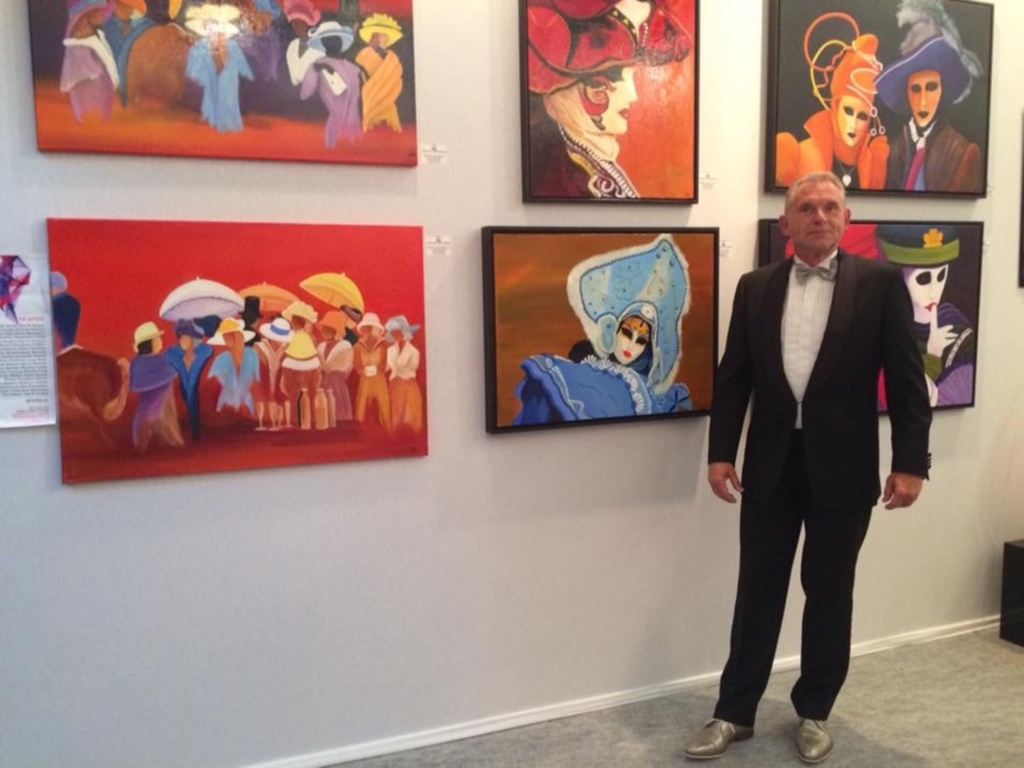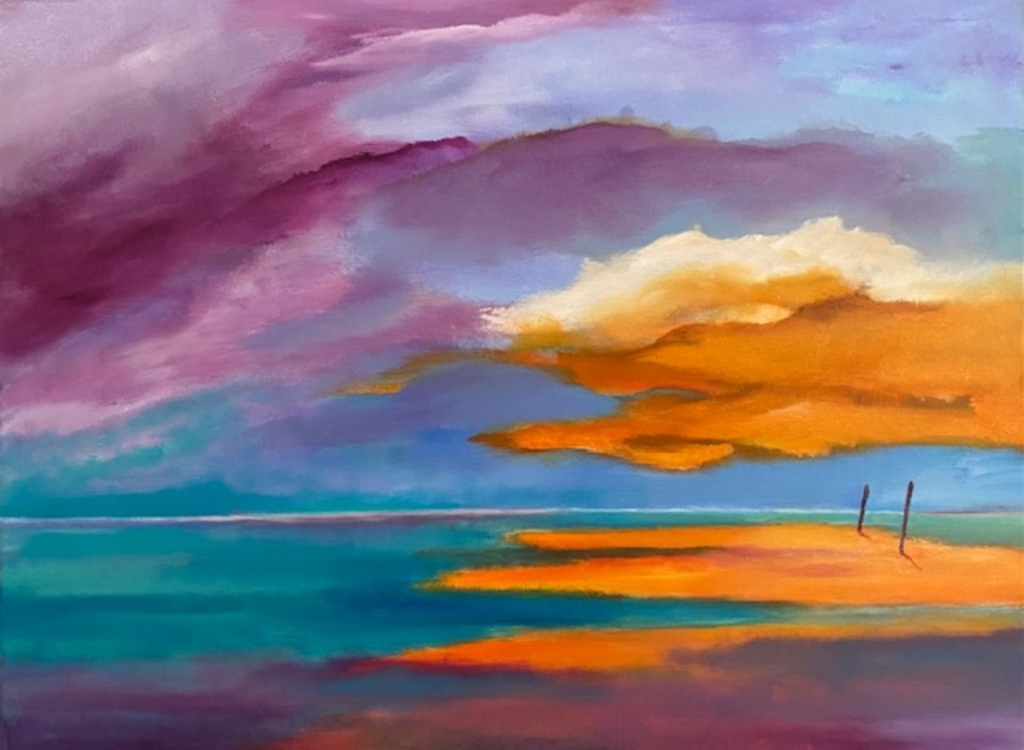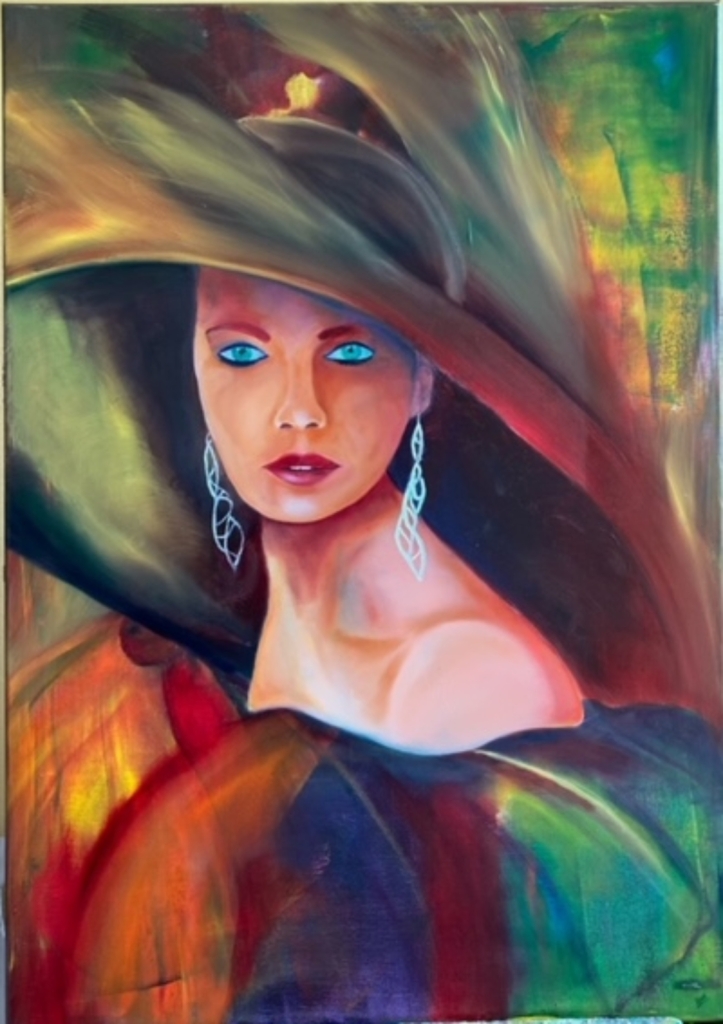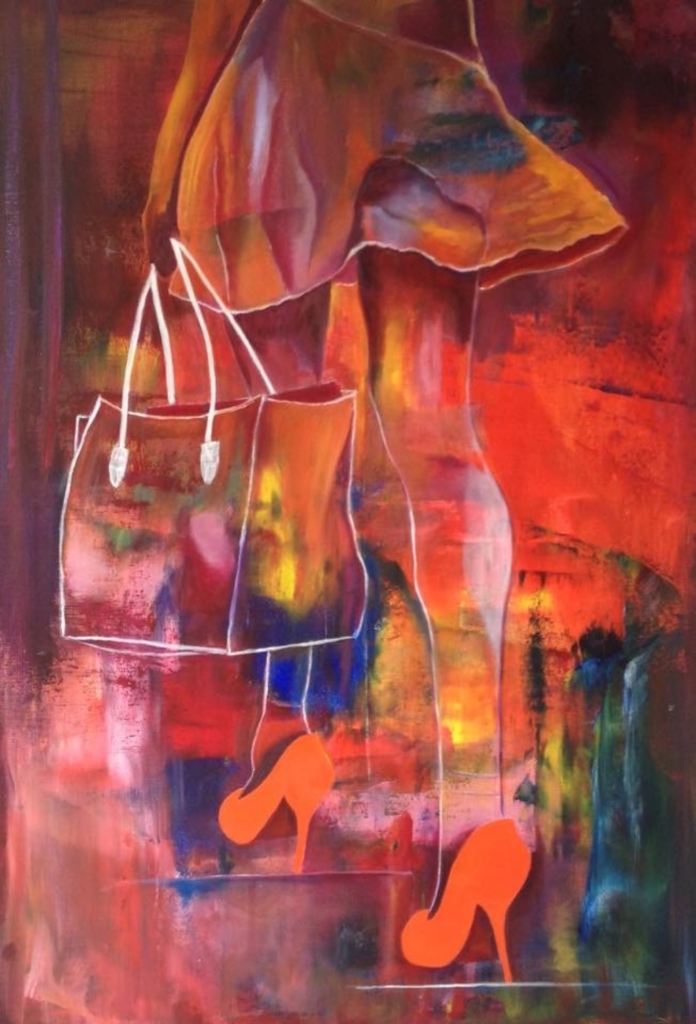di Marta Lock

Il mondo creativo dell’olandese Han de Leeuwerk è emerso in modo chiaro fin dall’infanzia quando la sua attività ludica prediletta era quella del dipingere e del disegnare perciò la sua strada sembrava indirizzata fin da subito verso la carriera artistica; tuttavia sorprendentemente ha scelto di mettere da parte il suo sogno per intraprendere gli studi in Legge ed Economia impostando la sua carriera sul mondo della razionalità, della logica, del controllo necessario a ottenere i risultati che i suoi clienti si aspettavano da lui. A volte capita che, a dispetto della consapevolezza della propria inclinazione verso il mondo artistico, alcuni sentano la necessità di lasciare che quel cammino maturi lentamente all’interno di sé, un po’ per apprendere a gestire la sfera emotiva che necessariamente deve emergere dalle chiusure e dalle barriere che l’individuo stesso pone, e un po’ perché il percorso di autocoscienza della propria reale natura deve passare a volte attraverso la privazione, il distacco da ciò che a livello istintivo si è consapevoli di essere ma che non si è in grado di ammettere. Poi però il percorso a cui si appartiene comincia a farsi strada e a diventare via via più incalzante fino a indurre a effettuare quel giro di boa inevitabile che de Leeuwerk ha compiuto all’età di quarant’anni, quando il desiderio di dedicare la sua vita all’arte era ormai inarginabile e impossibile da essere tenuto ancora in silenzio dalla parte razionale. Da quel momento in avanti la sua vita è cambiata, la gioia di concentrarsi solo sul lasciar fluire le sensazioni percepite attraverso la realtà osservata intorno a sé si è materializzata dal punto di vista pittorico in un tocco lieve, leggero, ammirato nei confronti di tutto ciò che cattura la sua attenzione, quel bel vivere che appartiene a chi è in grado di cogliere la positività e la piacevolezza in ogni istante dell’esistenza. Anche dal punto di vista stilistico emerge la poliedricità tipica di chi ha trattenuto a lungo l’istinto creativo e dunque sente il bisogno di sperimentare, di non poter rimanere all’interno di linee guida ben delineate che lo ricondurrebbero verso i medesimi limiti della sua vita precedente, quella votata alla razionalità e agli schemi legislativi entro i quali necessariamente doveva muoversi. Fortemente legato al Realismo ma con una gamma cromatica vicina all’Espressionismo, Han de Leeuwerk ha la capacità di rendere sognante il mondo che racconta, lasciando a volte trasparenze in grado di sospendere le scene descritte in una dimensione a metà tra sogno e realtà, come nell’opera Ladiesday at the races

in cui l’artista sembra evocare una scena sospesa nel tempo, quasi come se appartenesse a un’epoca passata e allo stesso modo a una presente, o come se in qualche modo la nostalgia del passato potesse diventare un esempio, uno stimolo a ritrovare il bel vivere e il bon ton in un presente che ha dimenticato le regole che fondavano la società di qualche decennio fa. La gamma cromatica è intensa ma anche delicata quando descrive le figure protagoniste che non presentano dettagli, quasi a sottolineare l’importanza di quel senso di comunità che nella vita moderna si è perduto. Quando invece il suo sguardo si perde nella natura circostante il tratto diviene più definito, anche se sempre orientato a descrivere l’atmosfera e l’emozione che dai paesaggi riceve e che sente il bisogno di comunicare all’osservatore; la tendenza in questa serie di opere più paesaggistiche, di cui fa parte la tela The Dutch mudflats

è quella di avvicinarsi al Romanticismo inglese, quell’esaltare la forza e la bellezza incontaminata esaltandone la maestosità non più però tempestosa come nelle opere di William Turner bensì calma, placida, tranquilla, tanto quanto lo è la stabilità emozionale raggiunta da Han de Leeuwerk da quando è giunto al suo approdo, quello del mondo artistico che ora è diventato la sua vita, la sua carriera e tutto ciò che sente di dover fare. Andiamo ora a conoscere l’artista attraverso la sua voce.
Han, lei ha scelto di mettere in secondo piano la sua forte inclinazione artistica scegliendo una professione schematica in cui il controllo attraverso la razionalità doveva essere predominante. Come è riuscito a controllare il suo lato creativo? E soprattutto qual è stata la ragione che la spinta a prendere una decisione tanto lontana dalla sua natura?
Quando ero giovane e dovevo fare una scelta sugli studi da intraprendere, l’ambiente in cui sono cresciuto e in cui vivevo non lasciava spazio a una formazione artistica. Negli anni successivi, ho utilizzato le mie doti creative in modo diverso, per risolvere questioni commerciali e legali. In questo modo sono riuscito a lasciarmi uno sfogo per la mia indole.

C’è stato un episodio specifico che ha determinato il giro di boa dei suoi quarant’anni, quello a seguito del quale è tornato al suo sogno di essere un artista, oppure è stata una decisione maturata lentamente?
Intorno a quell’età ho iniziato ad avere problemi fisici che mi hanno costretto a pensare a un’alternativa, a cosa potevo fare invece di continuare la mia vita frenetica e piena di impegni. Questo mi ha portato alla decisione di lasciarmi tutto alle spalle e di scegliere finalmente di essere un’artista, di dedicarmi a tempo pieno alla pittura. Una scelta che ha comportato non poche conseguenze per me e la mia famiglia, dal punto di vista finanziario e sociale. Malgrado tutto però so che è stata una buona scelta, perché mi ha portato di nuovo piacevolezza, entusiasmo e pace mentale.
Il suo stile è poliedrico poiché si modifica sulla base del soggetto che desidera rappresentare, questo processo avviene in maniera spontanea nel momento in cui si siede davanti alla tela? O invece si concretizza man mano che l’opera assume una sua struttura?
Principalmente accade più come la prima delle opzioni che ha indicato, ma a volte quel processo si mescola all’altro. Scelgo i miei temi in base alle sensazioni, alle cose che vedo intorno a me e che mi toccano. La domanda che mi pongo sempre è: posso trasformarlo in un dipinto, in un’ambientazione, in una figurazione e in tonalità che mi attraggono? Di solito inizio proprio dai colori. Di conseguenza, sulla tela si sviluppa uno sfondo colorato, che poi costituisce la base per determinare l’ambientazione e la figurazione. Qualsiasi idea precedente spesso scompare completamente in questa fase. Per questo motivo non faccio mai uno schizzo prima di cominciare a dipingere. Anche la gamma cromatica può cambiare durante questo processo. A proposito, credo che l’uso di più stili contribuisca a far sì che la pittura non diventi un trucco.

Le tonalità che contraddistinguono le sue opere sono vivaci, intense, vicine all’Espressionismo pur mantenendo uno stile realista; qual è l’ispirazione che la conduce a questa sinergia stilistica? Quali sono gli artisti del passato da cui attinge e quali sente più vicini alla sua poetica pittorica?
Non posso dire di avere maestri o stili preferiti. Come per la musica, posso apprezzare molti tipi e stili. Mi ispirano di più le singole opere d’arte che vedo nei musei, nelle mostre e sui social media, indipendentemente da chi le ha realizzate. I colori, la tecnica e la storia dietro l’opera d’arte sono gli elementi che devono toccarmi. Anche la profondità e la vivacità dei colori sono mentalmente molto importanti per me. Simboleggiano il mio atteggiamento verso la vita e controbilanciano anche parti della mia vita giovanile. L’esecuzione realistica è la traduzione del mio lato razionale.

Riverview (Vista sul fiume)
Lei ha clienti che le commissionano opere tanto quanto appassionati che amano acquistare di impatto una delle sue tele; quanto è importante aumentare la propria visibilità nel mondo artistico attuale per essere appetibile dai collezionisti? Dopo Miami, Monaco, Parigi, Londra, Firenze, Dubai e ovviamente Olanda, dove potremo vedere esposte le sue opere?
La visibilità è molto importante. Ancora più importante è avere un agente che ti metta in luce come artista e ti dia accesso allo scenario artistico. Purtroppo al momento non ne ho uno. Di conseguenza, devo dedicare molto tempo ad aspetti diversi dalla pittura. Quindi, se qualcuno dei lettori di questa intervista ha qualche collegamento o qualcuno da segnalarmi, gliene sarò molto grato.
Nell’autunno del 2022 esporrò a Seoul, in Corea del Sud, insieme a un artista coreano che sarà selezionato tra vari altri.
HAN DE LEEUWERK-CONTATTI
Email: leeuwerk@yahoo.com
Sito web: https://www.handeleeuwerkkunst.nl/
Facebook: https://www.facebook.com/han.deleeuwerk
Marta Lock’s interviews:
Han de Leeuwerk, the explosion of creativity after a life dedicated to rationality
The creative world of the Dutchman Han de Leeuwerk emerged clearly from his childhood when his favourite playful activity was painting and drawing, so his path seemed to be directed towards an artistic career right from the start. Surprisingly, however, he chosed to set aside his dream to pursue studies in Law and Economics, setting his career on the world of rationality, logic and the control necessary to obtain the results his clients expected from him. It sometimes happens that, despite the awareness of one’s inclination towards the artistic world, some people feel the need to let that path mature slowly within themselves, partly to learn how to manage the emotional sphere that must necessarily emerge from the closures and barriers that the individual himself places, and partly because the path of self-awareness of one’s true nature must sometimes pass through deprivation, detachment from what one is instinctively aware of being but is unable to admit. Then, however, the path to which one belongs begins to make its way and gradually becomes more and more insistent until it leads to that inevitable turning point that de Leeuwerk made at the age of forty, when the desire to devote his life to art was by then unquenchable and impossible to be kept silent by the rational side. From that moment onwards, his life changed, the joy of concentrating only on letting the sensations perceived through the reality observed around him flow, materialised from a pictorial point of view in a mild, light, admiring touch towards everything that captures his attention, that beautiful living that belongs to those who are able to grasp the positivity and pleasantness in every moment of existence. From a stylistic point of view, too, there emerges the multifacetedness typical of one who has held back his creative instinct for a long time and therefore feels the need to experiment, to be unable to remain within well-defined guidelines that would lead him back to the same limits of his previous life, the one devoted to rationality and the legislative schemes within which he necessarily had to move. Strongly linked to Realism but with a chromatic range close to Expressionism, Han de Leeuwerk has the ability to make the world he narrates dreamlike, sometimes leaving transparencies capable of suspending the scenes described in a dimension somewhere between dream and reality, as in the artwork Ladiesday at the races in which the artist seems to evoke a scene suspended in time, almost as if it belonged to a bygone era and likewise to a present, or as if somehow the nostalgia of the past could become an example, a stimulus to rediscover the good life and bon ton in a present that has forgotten the rules that founded society a few decades ago. The colour palette is intense but also delicate when he depicts the protagonist figures without details, as if to emphasise the importance of that sense of community that has been lost in modern life. When, on the other hand, his gaze is lost in the surrounding nature, the stroke becomes more defined, although always oriented towards describing the atmosphere and emotion that he receives from the landscapes and that he feels the need to communicate to the observer; The tendency in this series of more landscape-based paintings, of which The Dutch mudflats is a part, is that of coming closer to English Romanticism, that exalting the strength and uncontaminated beauty by exalting its majesty, no longer however stormy as in the artworks of William Turner, but rather calm, placid, tranquil, as much as the emotional stability achieved by Han de Leeuwerk since he arrived at his landing place, that of the artistic world that has now become his life, his career and all that he feels he must do. Let us now get to know the artist through his voice.
Han, you chosed to put your strong artistic inclination on the back burner by choosing a schematic profession where control through rationality had to be predominant. How did you manage to control your creative side? And above all, what was the reason that drove you to take a decision so far from your nature?
When I was young and had to make a choice about my studies, the environment in which I grew up and lived left no room for an artistic education. In later years, I used my creative talents in a different way, to solve business and legal issues. In this way I was able to give myself an outlet for my temperament.
Was there a specific episode that determined the turning point in your 40s, the one after which you returned to your dream of being an artist, or was it a decision that matured slowly?
Around that age, I started having physical problems that forced me to think about an alternative, about what I could do instead of continuing with my busy, hectic life. This led me to the decision to leave everything behind and finally choose to be an artist, to dedicate myself full-time to painting. It was a choice that had quite a few consequences for me and my family, both financially and socially. In spite of everything, however, I know that it was a good choice, because it brought me pleasure, enthusiasm and peace of mind again.
Your style is multifaceted as it changes according to the subject you wish to represent, does this process happen spontaneously the moment you sit down in front of the canvas? Or does it materialize as the artwork takes on his own structure?
Mostly it happens more like the first of the options you mentioned, but sometimes that process mixes with the other. I choose my themes based on feelings, on things I see around me that touch me. The question I always ask myself is: can I turn it into a painting, a setting, a figuration and hues that appeal to me? I usually start with the colours. Consequently, a coloured background develops on the canvas, which then forms the basis for determining the setting and figuration. Any previous ideas often disappear completely at this stage. That is why I never sketch before I start painting. The colour range can also change during this process. By the way, I believe that the use of several styles helps to ensure that painting does not become a trick.
The tones that characterize your artworks are vivid, intense, close to Expressionism while maintaining a Realist style; what is the inspiration that leads you to this stylistic synergy? Which artists from the past do you draw from and which do you feel are closest to your pictorial poetics?
I cannot say that I have any favourite masters or styles. As with music, I can appreciate many types and styles. I am most inspired by individual works of art that I see in museums, exhibitions and on social media, regardless of who created them. The colours, the technique and the story behind the artwork are the elements that must touch me. The depth and vividness of the colours are also mentally very important to me. They symbolise my attitude towards life and also counterbalance parts of my youthful life. The realistic execution is the translation of my rational side.
You have clients who commission paintings to you as much as enthusiasts who like to buy one of your canvases on impact; how important is it to increase your visibility in today’s art world in order to be attractive to collectors? After Miami, Munich, Paris, London, Florence, Dubai and of course Holland, where can we see your cavnases exhibited?
Visibility is very important. Even more important is to have an agent who can highlight you as an artist and give you access to the art scene. Unfortunately, I do not have one at the moment. As a result, I have to devote a lot of time to aspects other than painting. So if any of the readers of this interview have any connections or anyone to point me in the direction of, I will be very grateful.
In the autumn of 2022, I will be exhibiting in Seoul, South Korea, together with a Korean artist who will be selected from several others.
Instagram: https://www.instagram.com/handeleeuwerk_dutch_painter/
